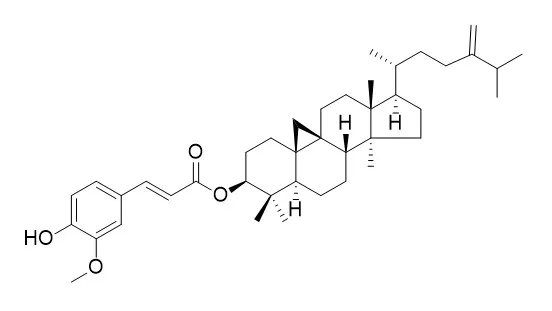| In vitro: |
| Indian J Biochem Biophys . 2014 Feb;51(1):75-80. | | Role of gamma-oryzanol in drought-tolerant and susceptible cultivars of rice (Oryza sativa L.)[Pubmed: 24791420] | | Drought-tolerant cultivars and their phytochemical composition, which has a role in providing drought tolerance are gaining importance. In this study, rice bran oil and semi-purified oryzanol (SPO) obtained from five rice (Oryza sativa L.) cultivars, namely P1401 and PB1 (drought-susceptible) and N22, PNR381 and APO (drought-tolerant) were analyzed for the gamma-oryzanol content, an antioxidant present in considerable amount in the rice bran. The higher level of gamma-oryzanol and its antioxidant activity was observed in drought-tolerant cultivars (N22, PNR381 and APO) as compared to drought-susceptible (PB1 and P1401), suggesting the role of gamma-oryzanol in drought tolerance, as antioxidants are known to play an important role by scavenging free radicals. The total antioxidant activity of gamma-oryzanol might be attributed to 24-Methylene cycloartanyl ferulate, a major component of gamma-oryzanol. By enhancing the level of active oryzanol components identified in this study by genetic and molecular means could impart increased drought tolerance. | | Biochem Biophys Res Commun . 2015 Dec 25;468(4):574-9. | | 24-Methylenecycloartanyl ferulate, a major compound of γ-oryzanol, promotes parvin-beta expression through an interaction with peroxisome proliferator-activated receptor-gamma 2 in human breast cancer cells[Pubmed: 26549231] | | Parvin-β is an adaptor protein that binds to integrin-linked kinase (ILK) and is significantly downregulated in breast tumors and breast cancer cell lines. We treated the breast cancer cell line MCF7 with 24-methylenecycloartanyl ferulate (24-MCF), a γ-oryzanol compound. We observed upregulation of parvin-β (GenBank Accession No. AF237769) and peroxisome proliferator-activated receptor (PPAR)-γ2 (GenBank Accession No. NM_015869). Among γ-oryzanol compounds, only treatment with 24-MCF led to the formation of reverse transcription-PCR products of parvin-β (650 and 500 bp) and PPAR-γ2 (580 bp) in MCF7 cells, but not in T47D, SK-BR-3, or MDA-MB-231 cells. 24-MCF treatment increased the mRNA and protein levels of parvin-β in MCF7 cells in a dose-dependent manner. We hypothesized that there is a correlation between parvin-β expression and induction of PPAR-γ2. This hypothesis was investigated by using a promoter-reporter assay, chromatin immunoprecipitation, and an electrophoretic mobility shift assay. 24-MCF treatment induced binding of PPAR-γ2 to a peroxisome proliferator response element-like cis-element (ACTAGGACAAAGGACA) in the parvin-β promoter in MCF7 cells in a dose-dependent manner. 24-MCF treatment significantly decreased anchorage-independent growth and inhibited cell movement in comparison to control treatment with dimethyl sulfoxide. 24-MCF treatment reduced the levels of GTP-bound Rac1 and Cdc42. Evaluation of Akt1 inhibition by 24-MCF revealed that the half maximal effective concentration was 33.3 μM. Docking evaluations revealed that 24-MCF binds to the ATP-binding site of Akt1(PDB ID: 3OCB) and the compound binding energy is -8.870 kcal/mol. Taken together, our results indicate that 24-MCF treatment increases parvin-β expression, which may inhibit ILK downstream signaling. | | Biochem Biophys Res Commun . 2015 Dec 25;468(4):574-9. | | 24-Methylenecycloartanyl ferulate, a major compound of γ-oryzanol, promotes parvin-beta expression through an interaction with peroxisome proliferator-activated receptor-gamma 2 in human breast cancer cells[Pubmed: 26549231] | | Parvin-β is an adaptor protein that binds to integrin-linked kinase (ILK) and is significantly downregulated in breast tumors and breast cancer cell lines. We treated the breast cancer cell line MCF7 with 24-methylenecycloartanyl ferulate (24-MCF), a γ-oryzanol compound. We observed upregulation of parvin-β (GenBank Accession No. AF237769) and peroxisome proliferator-activated receptor (PPAR)-γ2 (GenBank Accession No. NM_015869). Among γ-oryzanol compounds, only treatment with 24-MCF led to the formation of reverse transcription-PCR products of parvin-β (650 and 500 bp) and PPAR-γ2 (580 bp) in MCF7 cells, but not in T47D, SK-BR-3, or MDA-MB-231 cells. 24-MCF treatment increased the mRNA and protein levels of parvin-β in MCF7 cells in a dose-dependent manner. We hypothesized that there is a correlation between parvin-β expression and induction of PPAR-γ2. This hypothesis was investigated by using a promoter-reporter assay, chromatin immunoprecipitation, and an electrophoretic mobility shift assay. 24-MCF treatment induced binding of PPAR-γ2 to a peroxisome proliferator response element-like cis-element (ACTAGGACAAAGGACA) in the parvin-β promoter in MCF7 cells in a dose-dependent manner. 24-MCF treatment significantly decreased anchorage-independent growth and inhibited cell movement in comparison to control treatment with dimethyl sulfoxide. 24-MCF treatment reduced the levels of GTP-bound Rac1 and Cdc42. Evaluation of Akt1 inhibition by 24-MCF revealed that the half maximal effective concentration was 33.3 μM. Docking evaluations revealed that 24-MCF binds to the ATP-binding site of Akt1(PDB ID: 3OCB) and the compound binding energy is -8.870 kcal/mol. Taken together, our results indicate that 24-MCF treatment increases parvin-β expression, which may inhibit ILK downstream signaling. |
|






 Cell. 2018 Jan 11;172(1-2):249-261.e12. doi: 10.1016/j.cell.2017.12.019.IF=36.216(2019)
Cell. 2018 Jan 11;172(1-2):249-261.e12. doi: 10.1016/j.cell.2017.12.019.IF=36.216(2019) Cell Metab. 2020 Mar 3;31(3):534-548.e5. doi: 10.1016/j.cmet.2020.01.002.IF=22.415(2019)
Cell Metab. 2020 Mar 3;31(3):534-548.e5. doi: 10.1016/j.cmet.2020.01.002.IF=22.415(2019) Mol Cell. 2017 Nov 16;68(4):673-685.e6. doi: 10.1016/j.molcel.2017.10.022.IF=14.548(2019)
Mol Cell. 2017 Nov 16;68(4):673-685.e6. doi: 10.1016/j.molcel.2017.10.022.IF=14.548(2019)